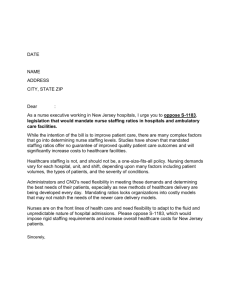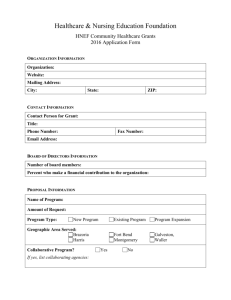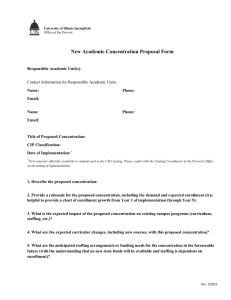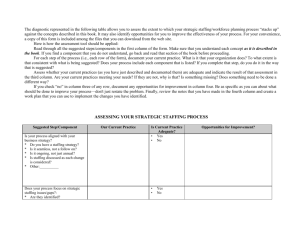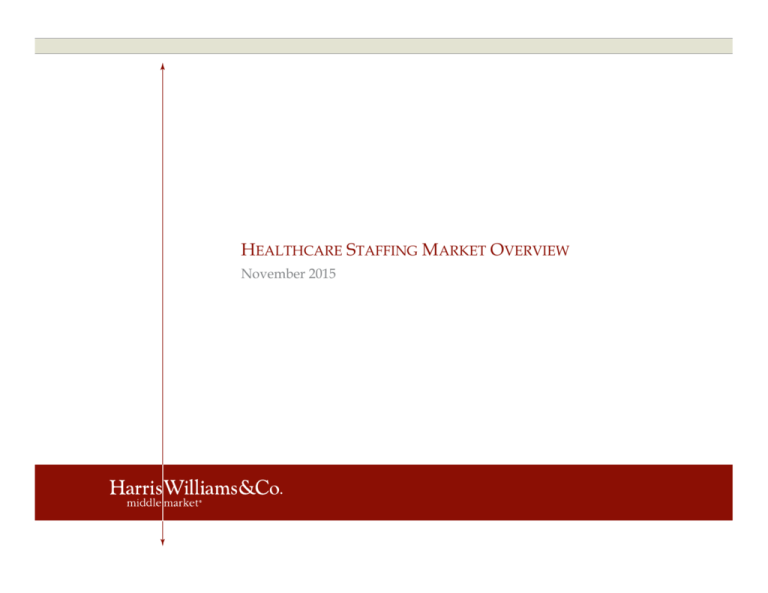
HEALTHCARE STAFFING MARKET OVERVIEW
November 2015
HEALTHCARE STAFFING INDUSTRY OVERVIEW
Healthcare staffing is an $11.1 billion industry in the United States, with expected growth
of 7% per annum through 2016P.
HEALTHCARE STAFFING MARKET BY TYPE1
Allied Health
Staffing of allied
professionals (e.g. radiology
technicians, physical
therapists) on multi-week
assignments
$3.2 bn
6% Growth
Per Diem Nursing
Travel Nursing
Locum Tenens
Staffing of registered nurses
to fill daily shifts
Staffing of registered nurses
on multi-week assignments
Staffing of physicians on
multi-week assignments
Nurse’s local market
Away from nurse’s home
Demand closely tied to
hospital census
Hospitalist, emergency
medicine, and primary care
are fastest growing
specialties
$3.0 bn
$2.2 bn
$2.7 bn
5% Growth
7% Growth
8% Growth
Source: Staffing Industry Analysts
(1) Figures represent 2015 segment size and 2014 – 2016P CAGR
1
HEALTHCARE STAFFING END MARKET OVERVIEW
Each service within the healthcare staffing industry fills a unique customer need and is
tailored to the demand characteristics.
Between the four main categories, there are significant differences in lead times, costs, and drivers of supply.
OVERVIEW OF HEALTHCARE STAFFING SERVICES
Order Lead
Time
Allied Health
Per Diem
Traditional Travel
Locum Tenens
NA
1 day
~5 weeks
NA
N/A
Fixed: 13 weeks
5 weeks to 6 months
Typically 13 weeks
Length of
Assignment
(Offer Per Diem to Permanent)
Hours per Week
~40 hours / week
12 hours / day
36 hours / week
60 hours / week
Average Bill
Rate / Fees
~$62 / hour1
~$45 / hour
~$59 / hour
~$171 / hour
Average Pay
Rate
~$32 / hour1
~$30 / hour
~$30 / hour
~$120 / hour
Weekly Pay to
Profession
~$1,280
~$7202
~$1,080
~$7,250
Client Need
Fill temporary
hiring need
Backfill for Sick
Days or Vacation
Seasonal or
Routine
Fill temporary
hiring need
Source: Staffing Industry Analysts, locumtenens.com, ONYX M.D., National Association of Locum Tenens Organizations, industry participant websites
(1) As of 2012
(2) Assumes two days worked per week
2
COST AND QUALITY PRESSURES DRIVE DEMAND FOR FLEXIBLE STAFFING
Mounting regulatory and economic pressures are forcing hospitals to increase the focus
on cost efficiency and reduced readmissions rates.
Healthcare facilities operate with a base of fixed labor supplemented with a component of variable labor in order to align staffing costs
with patient census variability.
Rise in importance of quality of care driving demand for skilled personnel
2
3
New regulations
increase
compliance costs
Capital expenditures
are expanding in
conjunction with
increased utilization
1
4
Uncertainty around
future reimbursement
rates
Bundled payments
increase importance
and cost of
postoperative care
Flexible staffing provides hospitals the ability to optimize
fixed vs. variable personnel costs
3
STAFFING INDUSTRY GROWTH CONTINUES TO ACCELERATE
Supported by favorable trends, the healthcare staffing industry is expected to generate
robust growth.
Healthcare staffing services demand is expected to grow at a 6.6% CAGR through 2016P, primarily driven by the following growth drivers:
― Increase insured population due to ACA, and resulting increase in healthcare utilization
― Aging “Boomer” population
― Ongoing nurse and professional shortages
Hospitals continue to seek efficient staffing levels as personnel currently represent 54% of total hospital expenses (1).
FAVORABLE HEALTHCARE SPENDING TRENDS
COUPLED WITH ACCELERATED HEALTHCARE STAFFING EXPANSION
($ in billions)
($ in billions)
$6,000
’15E – ’22P CAGR
6.2%
$5,000
$4,416
$4,000
$3,093
$3,273
$3,458
$3,660
$3,889
‘09 – ‘14 CAGR
3.7%
$5,009
$4,702
$4,142
$3,000
‘14 – ‘16P CAGR
6.6%
$12
$10
$8
$8.6
$8.9
$9.5
$9.7
$10.3
$11.1
$11.7
$7.9
$6
$4
$2,000
$2
$0
$1,000
2014
2015E 2016P 2017P 2018P 2019P 2020P 2021P 2022P
National Health Expenditures
Source: Centers for Medicare & Medicaid Services, Staffing Industry Analysts
(1) Fitch Ratings
2009
2010
2011
2012
2013
2014
Allied Health
Locum Tenens
Travel Nursing
2015E 2016P
Per Diem Nursing
4
KEY INDUSTRY GROWTH DRIVERS:
INCREASED HEALTHCARE UTILIZATION
The Affordable Care Act (“ACA”) has increased access to healthcare for the uninsured
and underinsured, resulting in increased healthcare utilization.
ACA is expected to provide ~25 million previously uninsured Americans with health insurance by 20201.
16.4 million more adults have gained insurance coverage since 2010 as a result of the ACA provisions (as of May 5, 2015).
Hospital reimbursement payments are being realigned with quality metrics to improve overall quality of care, and include financial
penalties for high readmission rates.
― Hospitals are expected to utilize increased variable healthcare staffing solutions to avoid costly penalties and maintain quality
metrics
― Nurse unions consistently push for lower nurse-to-patient ratios, which research suggests, are correlated with lower readmission rates
ADDITIONAL INSURED AMERICANS UNDER ACA
(in millions)
30
23
25
20
24
24
24
2014
2024
86% / 232m
92% / 262m
Insured
Insured
25
17
14
15
10
5
3
0
2013
2014
2015E
2016P
2017P
2018P
2019P
2020P
25 MILLION ADDITIONAL INSURED BY 2020
(1)
(2)
Congressional Budget Office
An additional 5 million Americans are projected to be insured between 2020 to 2024
30 MILLION ADDITIONAL INSURED BY 2024 (2)
5
KEY INDUSTRY GROWTH DRIVERS:
AGING POPULATION
The aging U.S. population is expected to drive increased demand for healthcare
services, specifically in acute care environments.
Americans over 65 are expected to grow from 40 million in 2010 to 73 million in 2030, representing a CAGR of ~3.0%
Increased elderly population will drive healthcare utilization, as this population is more susceptible to diseases and physical ailments that
require acute care.
― According to IMS Health, nearly 90% of seniors have one chronic condition and 70% have multiple conditions
― Elderly Americans are three times more likely to have a hospital stay in a given year, and once admitted, the average length of
hospital stay is longer than for other age groups
U.S. POPULATION AGED 65 OR OLDER
AVERAGE LENGTH OF HOSPITAL STAY
(in millions)
(Days)
+81%
80
72.8
70
40
25.2
31.2
35.0
40.3
4.5
5.5
5.0
5.0
50
30
5.7
5.4
5.5
56.0
60
6.0
4.5
4.0
3.6
20
3.5
10
3.0
0
1980
1990
2000
Source: U.S. Census Bureau
2010
2020P
2030P
<15 Years
15-44
Years
45-64
Years
65-74
Years
75-85
Years
85+ Years
6
KEY INDUSTRY GROWTH DRIVERS:
EXPECTED HEALTHCARE STAFFING SHORTAGE
Sustained healthcare professional shortages will continue to drive temporary staffing
demand.
66% of hospitals are already feeling a material shortage in nurses, driving increased use of temporary staffing solutions.
― Legislative changes, quality of care standards, and an aging population point to increased demand
― Decreasing ratio of nurses to patients generates quality and continuity of care issues that correlate to adverse patient outcomes
Evidence suggests shortages of nurse and physician enrollees, limiting the future supply of healthcare professionals at a time when the
need for medical personnel continues to grow.
Growing geographic imbalances in supply and demand will benefit staffing firms capable of mobilizing highly specialized practitioners in
distinct geographic areas.
RAPIDLY RISING SHORTAGES FOR NURSES…
…AND PHYSICIANS
Substantial increase in % of hospitals
reporting over 5% RN vacancy
The total physician shortage is expected to expand from 1% to 8%
of total demand, driving an increased need for locum tenens
72,800
shortage
100%
900,000
41% report
>5%
vacancy
80%
66% report
>5%
vacancy
60%
40%
20%
# of Physicians
% of Hospitals Reporting
RN Vacancies
950,000
850,000
800,000
11,000
shortage
750,000
700,000
0%
2012
<5.0%
7.5% to 9.9%
12.5%+
2015
5.0% to 7.49%
10.0% to 12.49%
650,000
2013
Total Physician Demand
Source: Health Resources and Services Administration; Nursing Solutions Inc., U.S. Census Bureau; Association of American Medical Colleges
2025
Total Physician Supply
7
INDUSTRY PARTICIPANTS OVERVIEW
The healthcare staffing market remains substantially fragmented, with the top ten
participants commanding approximately 40% of the market.
Many of the top industry players are still privately owned and operated businesses.
While private equity firms have begun to participate in the space in recent years, consolidation has been limited with only a couple large
diversified staffing firms entering the sector.
A majority of the top firms provide multiple staffing services, enabling them to act as a one-stop-shop for hospitals and medical facilities
seeking to efficiently manage their personnel needs.
OVERVIEW OF HEALTHCARE STAFFING SERVICES MARKET PARTICIPANTS BASED ON 2014 RESULTS
$991
$912
$702
$530
$328
$256
$218
$212
$180
$148
$137
$137
$133
$128
$125
Market Share
9%
9%
7%
5%
3%
2%
2%
2%
2%
1%
1%
1%
1%
1%
1%
Services
Allied Health
Per Diem Nursing
Locum Tenens
Travel Nursing
Public
Private
Revenue ($ mm)
Diversified Staffing
Ownership
Public
Public
Private
Private
Source: Staffing Industry Analyst based on 2014 data
Private
Public
Private
8
INDUSTRY LANDSCAPE AND M&A
The U.S. healthcare staffing M&A market has shown strong activity over the last two
years.
The U.S. healthcare staffing industry continues to experience consolidation with 16 transactions occurring in 2014.
― Competitive space is still very fragmented with no firm maintaining greater than a 10% market share
― Firms continue to employ M&A strategies to diversify service lines and to expand their geographical footprint
― Cost efficient for firms to acquire targets rather than grow internally
Industry has drawn attention from both private equity groups as well as large multinational staffing corporations.
SELECT TRANSACTIONS IN THE HEALTHCARE STAFFING INDUSTRY
Date
Target Company
Acquirer
Date
Nov -15
B.E. Smith
AMN Healthcare Serv ices
Dec-14
Thomas H. Lee
Jul-14
Sep-15
Sep-15
Jun-15
Healthcare Staffing
Solutions
Medical Solutions
Adv anced Medical
Personnel Serv ices
Beecken Petty O'Keefe &
Company
Jun-14
Clearv iew Capital
Dec-13
Target Company
Onward Healthcare,
Locum Leaders, Medefis
MedAscend
Medical Staffing Network
Healthcare
Allied Healthcare Staffing
Div ision
Acquirer
AMN Healthcare Serv ices
Accountable Healthcare
Staffing
Cross Country Healthcare
Local Staff, LLC
Feb-15
VISTA Staffing Solutions
EmCare Inc.
May-13
Locum Leaders, LLC
OGH, LLC
Jan-15
Av antas
AMN Healthcare Serv ices
Feb-13
OA Nurse Trav el, LLC
Medical Solutions L.L.C.
Dec-14
Sagent Healthstaff
Accountable Healthcare
Staffing
Nov -12
CHG Healthcare Serv ices,
Inc.
Leonard Green & Partners
9
DISCLOSURES
Harris Williams & Co. (www.harriswilliams.com) is a preeminent middle market investment bank focused on the advisory needs
of clients worldwide. The firm has deep industry knowledge, global transaction expertise, and an unwavering commitment to
excellence. Harris Williams & Co. provides sell-side and acquisition advisory, restructuring advisory, board advisory, private
placements, and capital markets advisory services.
Investment banking services are provided by Harris Williams LLC, a registered broker-dealer and member of FINRA and SIPC,
and Harris Williams & Co. Ltd, which is authorized and regulated by the Financial Conduct Authority. Harris Williams & Co. is a
trade name under which Harris Williams LLC and Harris Williams & Co. Ltd conduct business.
THIS REPORT MAY CONTAIN REFERENCES TO REGISTERED TRADEMARKS, SERVICE MARKS AND COPYRIGHTS OWNED BY THIRDPARTY INFORMATION PROVIDERS. NONE OF THE THIRD-PARTY INFORMATION PROVIDERS IS ENDORSING THE OFFERING OF, AND
SHALL NOT IN ANY WAY BE DEEMED AN ISSUER OR UNDERWRITER OF, THE SECURITIES, FINANCIAL INSTRUMENTS OR OTHER
INVESTMENTS DISCUSSED IN THIS REPORT, AND SHALL NOT HAVE ANY LIABILITY OR RESPONSIBILITY FOR ANY STATEMENTS MADE
IN THE REPORT OR FOR ANY FINANCIAL STATEMENTS, FINANCIAL PROJECTIONS OR OTHER FINANCIAL INFORMATION CONTAINED
OR ATTACHED AS AN EXHIBIT TO THE REPORT. FOR MORE INFORMATION ABOUT THE MATERIALS PROVIDED BY SUCH THIRD
PARTIES, PLEASE CONTACT US AT THE ABOVE ADDRESSES OR NUMBERS.
The information and views contained in this report were prepared by Harris Williams & Co. (“Harris Williams”). It is not a
research report, as such term is defined by applicable law and regulations, and is provided for informational purposes only. It
is not to be construed as an offer to buy or sell or a solicitation of an offer to buy or sell any financial instruments or to
participate in any particular trading strategy. The information contained herein is believed by Harris Williams to be reliable, but
Harris Williams makes no representation as to the accuracy or completeness of such information. Harris Williams and/or its
affiliates may be market makers or specialists in, act as advisers or lenders to, have positions in and effect transactions in
securities of companies mentioned herein and also may provide, may have provided, or may seek to provide investment
banking services for those companies. In addition, Harris Williams and/or its affiliates or their respective officers, directors and
employees may hold long or short positions in the securities, options thereon or other related financial products of companies
discussed herein. Opinions, estimates and projections in this report constitute Harris Williams’ judgment and are subject to
change without notice. The financial instruments discussed in this report may not be suitable for all investors, and investors
must make their own investment decisions using their own independent advisors as they believe necessary and based upon
their specific financial situations and investment objectives. Also, past performance is not necessarily indicative of future
results. No part of this material may be copied or duplicated in any form or by any means, or redistributed, without Harris
Williams’ prior written consent.
Copyright © 2015 Harris Williams & Co., all rights reserved.
10

